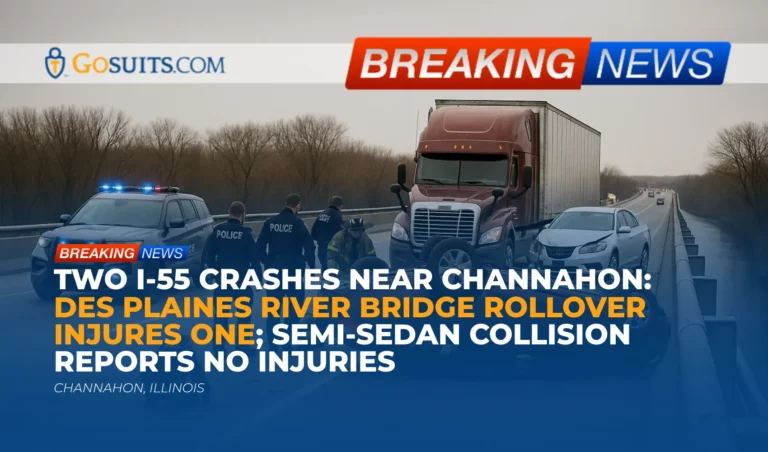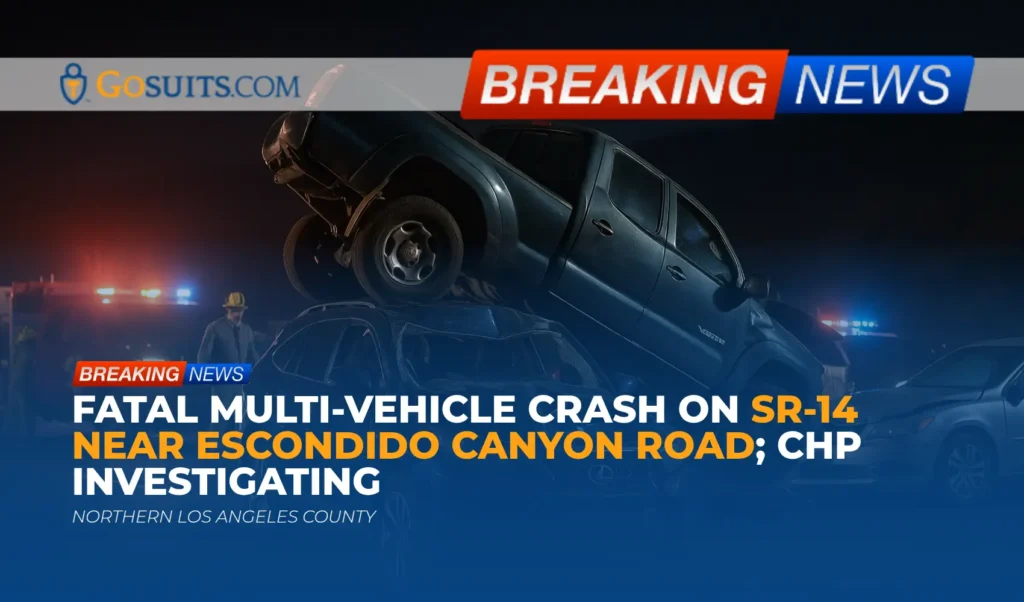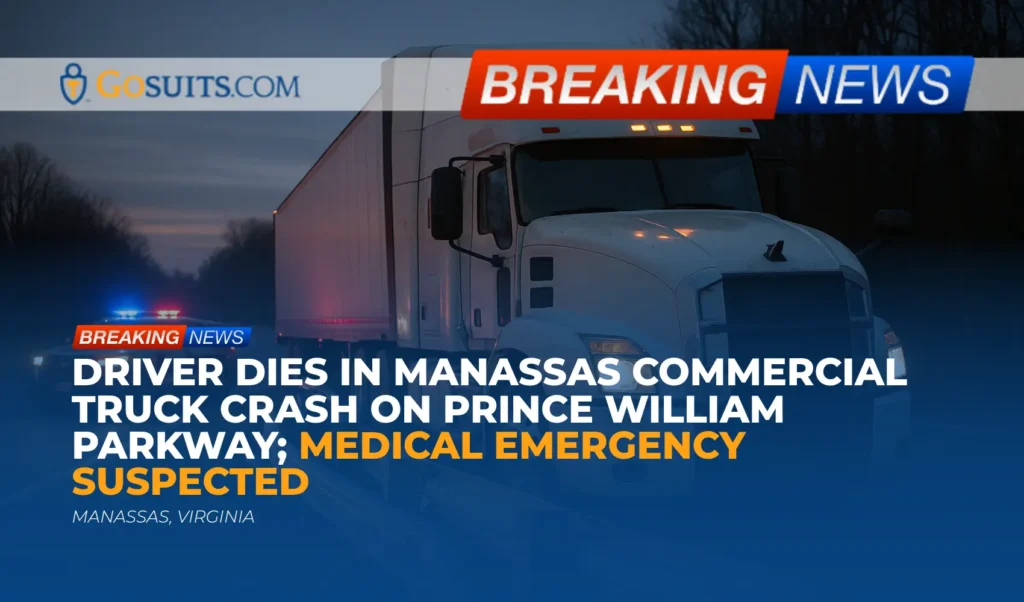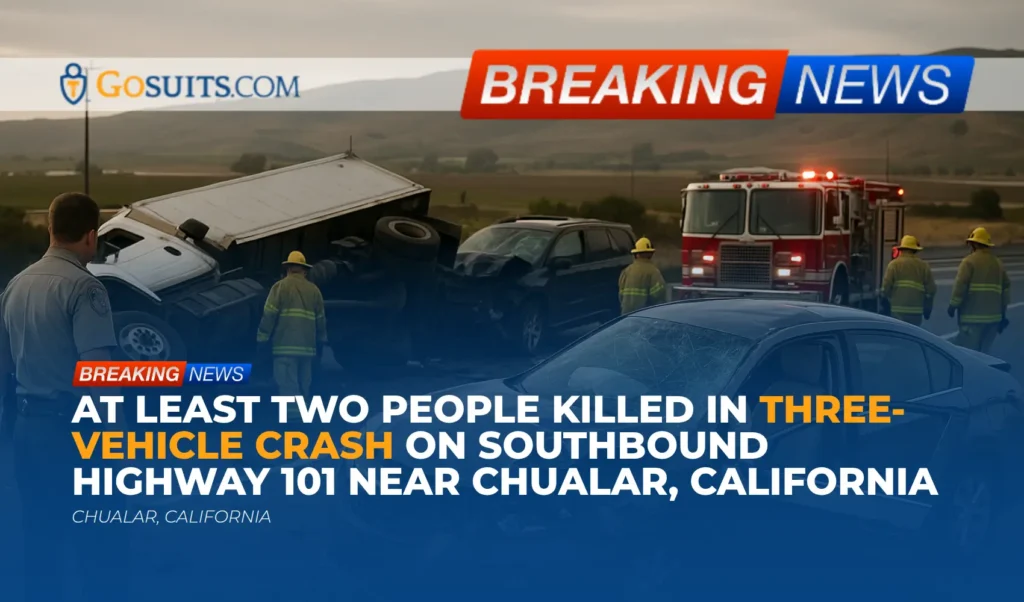- Overview of the two Interstate 55 crashes near Channahon
- Key facts from law enforcement
- What multi-vehicle and rollover crashes on bridges often involve
- How Illinois crash investigations typically proceed
- Legal rights after an Illinois interstate crash
- Where to obtain official records and information
- Health and recovery after a highway collision
- Insurance considerations and common pitfalls
- Road safety takeaways for I-55 drivers
- Next steps: Why acting promptly matters
- Commentary from Gosuits Channahon, Illinois Personal Injury Attorney
Overview of the two Interstate 55 crashes near Channahon
Illinois State Police responded to two separate crashes Thursday on Interstate 55 near Channahon. The first was a four-vehicle rollover crash on the Des Plaines River Bridge around 10:10 a.m. One person was transported to a local hospital with injuries. All lanes were closed for about an hour for cleanup. A second crash, reported around noon in the southbound lanes near Channahon, involved a semi-truck and a sedan. Authorities reported no injuries and no lane blockage for the second incident. State police did not release information on the causes of either crash at the time of reporting.
Crashes at or near river bridges and heavy truck corridors like I-55 can be complex, with traffic patterns, speed differentials, and visibility all playing roles. Even when injuries at the scene appear minor, the stress of a rollover, airbag deployment, and sudden deceleration can lead to injuries that emerge over hours or days. For those involved, it is common to feel overwhelmed by questions about medical care, insurance obligations, and how to obtain official records. The aim of this article is to clearly summarize what is publicly known, provide practical steps to find reliable information, and outline general legal context from a personal injury perspective under Illinois law.
Key facts from law enforcement
What happened
Based on the information provided by state police:
- First crash: A four-vehicle collision with a rollover on the Des Plaines River Bridge on Interstate 55, around 10:10 a.m. Thursday. One person was transported to a local hospital. All lanes were closed for roughly an hour for cleanup and scene management.
- Second crash: A semi-truck and a sedan collided in the I-55 southbound lanes near Channahon around noon. No injuries or lane closures were reported for this crash.
- Cause: The Illinois State Police did not release the cause of either crash at the time of reporting.
Who was involved
The first crash involved four vehicles; the second involved a commercial semi-truck and a passenger sedan. No identifying details about the motorists have been released, and the report does not describe the age or hometown of the individuals involved. One person from the first crash sustained injuries warranting hospital transport.
Where and when
- Location: Interstate 55 near Channahon, including the Des Plaines River Bridge area.
- Timing: First crash around 10:10 a.m.; second crash around 12 p.m., both on Thursday.
- Traffic impact: The first crash led to an approximately one-hour full lane closure; the second caused no reported blockage.
What multi-vehicle and rollover crashes on bridges often involve
While the specific causes of Thursday’s crashes were not released, it can be helpful to understand common patterns in bridge-area, multi-vehicle, and truck-involved collisions. This helps families and drivers recognize why thorough investigation and documentation matter.
Common contributing elements (general, not specific to these crashes)
- Speed differentials and sudden braking: On busy interstates, particularly near bridges and merges, traffic speeds can change abruptly, heightening rear-end and chain-reaction risks.
- Limited escape routes: A bridge deck typically leaves minimal shoulder space. When a crash starts, nearby drivers have fewer options to avoid involvement.
- Lane changes and visibility: Commercial trucks can have significant blind spots and longer stopping distances. Passenger vehicles may misjudge the time and space needed to merge or pass safely around heavy trucks.
- Surface conditions: Bridge decks can behave differently than standard pavement in certain weather and temperature conditions. Even without precipitation, surface irregularities, debris, or lingering fluids from prior incidents can affect traction.
- Rollover dynamics: Rollovers can occur when a vehicle is struck at certain angles, when rapid steering inputs occur to avoid a hazard, or when the center of gravity shifts abruptly due to impact forces.
Why chain-reaction collisions can involve multiple vehicles
On a high-speed corridor, one triggering event can cause a series of impacts. Following distance, driver attention, road geometry, and traffic density all influence whether a single two-vehicle crash expands into a multi-vehicle incident. The presence of a heavy truck can increase the severity due to mass and stopping distances, even when the truck driver is attentive and compliant with safety rules.
How Illinois crash investigations typically proceed
After interstate crashes, law enforcement and, when necessary, specialized crash reconstruction teams work to document and interpret the scene. Although the Illinois State Police have not released causal findings here, investigations often include the following steps:
- Scene documentation: Officers capture measurements, roadway evidence, debris fields, final rest positions, and skid or yaw marks. They may use laser mapping tools and photographs.
- Witness and driver statements: Statements are collected at the scene and sometimes later, once injured parties are medically stable. In complex crashes, interviews may be supplemented by diagrams and reports.
- Vehicle inspections: Vehicles may be examined for mechanical issues, damage patterns, event data recorder (EDR) downloads, and airbag control module information that can reveal speed, braking, and restraint use in the moments before impact.
- Commercial carrier checks: If a semi-truck is involved, investigators may review the driver’s hours-of-service logs, inspection records, and other materials required under federal safety regulations.
- Environmental review: Lighting, weather, traffic control devices, road design, and any temporary hazards (like fluid on pavement) may be evaluated.
Crash data and national trends underscore the importance of careful analysis. NHTSA reported 42,514 traffic fatalities nationwide in 2022, a reminder that highway incidents are a serious public safety concern even when an individual crash seems “minor” at first glance. See NHTSA’s summary on 2022 fatalities here: NHTSA 2022 traffic deaths.
Legal rights after an Illinois interstate crash
The following general principles often apply to Illinois personal injury cases arising from motor vehicle collisions. This information is for educational purposes; individual situations vary and should be discussed with a qualified professional.
Fault and comparative negligence
Illinois follows modified comparative fault. A claimant may recover damages reduced by their percentage of fault, but recovery is barred if their fault exceeds 50 percent. See the Illinois statute: 735 ILCS 5/2-1116.
In multi-vehicle crashes, fault can be allocated among multiple drivers. For example, rear-end impacts often suggest following distance issues, while unsafe lane changes can shift liability elsewhere. A thorough investigation looks at each driver’s conduct, vehicle data, and independent evidence like dashcam footage.
Timelines to bring a claim
- Personal injury: In many Illinois motor vehicle cases, the general statute of limitations is two years from the date of injury. See 735 ILCS 5/13-202.
- Wrongful death: Generally, actions must be commenced within two years of death, though specific circumstances can affect timing. See 740 ILCS 180/2.
Shorter notice requirements may apply in certain scenarios, including claims involving government entities or roadway conditions. Claims against the State of Illinois may fall under the Illinois Court of Claims process. For general information, see the Court of Claims site: Illinois Court of Claims.

Commercial trucks and added layers of responsibility
When a semi-truck is involved, additional layers of potential responsibility and insurance coverage may exist, including the motor carrier and, in some cases, entities responsible for maintenance or cargo. Federal safety rules govern driver qualifications, hours of service, vehicle inspections, and more. The Federal Motor Carrier Safety Administration provides safety guidance and highlights the importance of space management due to longer stopping distances: FMCSA space management.
Because of the complexity of evidence and multiple parties, early evidence preservation can be crucial, including letters requesting that carriers retain logs, EDR data, maintenance files, and dashcam footage.
Damages that may be available
In civil motor vehicle cases, recoverable damages can include medical expenses, lost wages, pain and suffering, loss of normal life, and property damage. The specific categories and amounts depend on evidence and Illinois law. Every case is different, and outcomes depend on facts that require careful review.
Where to obtain official records and information
Official records help clarify what happened and can be vital for insurance claims and civil cases. The following resources are commonly relevant after an Illinois interstate crash.
Illinois State Police crash reports
- Crash report access: The Illinois State Police maintains crash report information and provides public access in accordance with state law. Begin at the ISP’s official site for directions on obtaining a report: Illinois State Police.
- District jurisdiction: Interstate 55 near Channahon generally falls under ISP’s district coverage in the area. For district contact information and instructions, use the ISP directory from the official site above.
- Supplemental records: Photos, diagrams, and 911 audio may require a formal records request. Consider submitting a written records request and following ISP guidance on any applicable fees or processing times.
Medical and, where applicable, coroner or autopsy records
- Medical records: Treating hospitals and clinics will have the records needed to document injuries. Patients can request copies for personal use and claims.
- Death records: If a fatality is involved in a traffic incident, death certificates are issued through the Illinois Department of Public Health’s system. See IDPH’s overview of death records and certified copy procedures: IDPH death records.
- Autopsy reports: In Illinois, county coroners or medical examiners handle autopsy records. Procedures vary by county. If needed, identify the coroner’s office with jurisdiction over the place of death and ask about their process, ID requirements, and any fees.
Freedom of Information Act (FOIA) guidance
If additional public records are needed, Illinois law provides mechanisms to request them. For statewide FOIA guidance and best practices, see the Illinois Attorney General’s FOIA resources: Illinois FOIA information. Agency-specific FOIA pages, such as ISP’s, explain where to submit requests and what to include. Be as specific as possible about dates, times, locations, involved vehicles, and the type of records sought.
Traffic management updates
For future incidents and travel planning, official state sources provide updates about lane closures and incidents. The Illinois Department of Transportation and state-run traveler information services publish advisories, which can help drivers avoid secondary crashes and congestion. Use only official government traveler information sites and broadcasts for real-time updates.
Health and recovery after a highway collision
Even when individuals walk away from a crash, some injuries emerge later. Soft tissue injuries, concussions, and psychological stress responses may not be fully apparent at the scene. It is common for soreness and stiffness to increase 24 to 48 hours after a collision.
- Concussion awareness: Headaches, dizziness, confusion, or sensitivity to light and noise can be signs of a concussion. For an overview of symptoms and when to seek care, see the Centers for Disease Control and Prevention: CDC concussion symptoms.
- Follow-up care matters: Early medical evaluation documents the connection between the crash and the symptoms, supports appropriate treatment, and can be important if an insurance claim is made later.
- Keep a symptom log: Note pain levels, mobility limitations, missed work, and any new symptoms. Share updates with your healthcare provider.
Emotional wellbeing is also part of recovery. Intrusive memories, anxiety about driving, sleep disturbance, and irritability can follow a sudden crash event. Primary care providers can refer patients to appropriate support if these symptoms persist.
Insurance considerations and common pitfalls
Insurance issues can be confusing in multi-vehicle and truck-involved crashes. The order of phone calls and the wording used in statements can influence how claims unfold. The following general points often apply in Illinois motor vehicle cases.
- Consider professional guidance before giving recorded statements: What someone says to an insurer can be used later. It is generally wise to understand your rights before providing a detailed statement to any insurer, whether your own or another driver’s.
- Property damage claims vs. injury claims: These can proceed on different timelines. Ensure medical issues are evaluated and documented before finalizing any bodily injury settlement.
- Uninsured/underinsured motorist (UM/UIM): If an at-fault driver is unidentified or has insufficient coverage, your own UM/UIM coverage may help. Policy language varies, and deadlines for notifying your carrier can be short.
- Medical payments coverage (MedPay): Some policies include MedPay to help with initial medical bills regardless of fault. How and when it applies depends on the policy.
- Commercial insurance layers: If a semi-truck is involved, there may be multiple policies and adjusters. Early identification of all potentially responsible parties is important.
- Avoid quick settlements without understanding future needs: Early offers sometimes come before full medical evaluation. Settlements are typically final, so it is prudent to clarify the long-term impact of injuries before agreeing to resolve a claim.
Because each case is unique, consider obtaining a free consultation to understand the implications of giving statements to insurers, signing medical authorizations, or accepting offers. Speaking carefully with any insurer is prudent, as statements can affect the outcome later.

Road safety takeaways for I-55 drivers
Busy interstate corridors that serve both commuter and heavy commercial traffic call for extra caution. General safety measures include:
- Increase following distance: This creates space to react to sudden slowdowns, especially on bridge spans and near merges.
- Give trucks more room: Commercial motor vehicles have larger blind spots and longer stopping distances. FMCSA emphasizes space management to reduce conflicts with heavy trucks: FMCSA space management.
- Avoid abrupt lane changes: Sudden movements can lead to overcorrection and instability, especially at interstate speeds.
- Stay alert to evolving conditions: Debris, disabled vehicles on the shoulder, or cleanup activities after an earlier incident can increase risk unexpectedly.
- Plan for delays: If a crash closes lanes, remain patient and avoid distracted driving while stopped or creeping forward.
Despite everyone’s best efforts, collisions can still occur. If you are involved in a crash, prioritize safety, seek medical evaluation, and document as much as possible without putting yourself or others at risk.
Next steps: Why acting promptly matters
This section outlines practical, time-sensitive steps that help protect health, documentation, and legal options. It is intended for general educational purposes.
- Obtain the official crash report: Follow the Illinois State Police process to request the report for the specific I-55 incidents. Reports are typically needed for insurance claims and provide the basic facts and officer observations.
- Preserve evidence immediately: Save photos, dashcam clips, vehicle telematics, and contact details for witnesses. Ask that damaged vehicles not be repaired or disposed of until documentation is complete.
- Continue medical evaluation: Follow up with healthcare providers, complete recommended imaging or therapy, and keep all discharge instructions and billing records.
- Be cautious with insurance communications: Before giving recorded statements or signing broad medical authorizations, get a clear understanding of rights and obligations. Statements can be used later.
- Calendar key deadlines: Statute of limitations periods under Illinois law can be as short as two years for personal injury. Potential claims involving government entities may carry additional notice requirements. Mark dates and build in a buffer.
- Consider a free consultation: An early consultation can clarify potential parties, insurance layers, and immediate preservation needs. It also helps prevent missteps that could narrow options later.
Acting promptly can improve access to accurate records, safeguard crucial evidence, and reduce the risk of inadvertently limiting available claims. Delay can make it harder to locate witnesses, retrieve video, or preserve commercial carrier data.
Commentary from Gosuits Channahon, Illinois Personal Injury Attorney
We extend our sincere concern to everyone affected by the two crashes on Interstate 55 near Channahon, especially the individual transported from the rollover on the Des Plaines River Bridge. This commentary is offered for general information and education in the aftermath of an unsettling day on a busy highway.
From a personal injury standpoint, multi-vehicle and bridge-area incidents require careful fact gathering before drawing conclusions. Thursday’s reports confirm a four-vehicle rollover with injuries and a separate truck–sedan crash with no reported injuries or lane closures. Because the Illinois State Police did not announce a cause, the next steps usually focus on documentation: official crash reports, scene photographs if available, EDR data, and any witness accounts. In a chain-reaction setting, even small timing differences can shift responsibility among multiple drivers and vehicles. When a semi-truck is part of the equation, additional commercial records and federal safety considerations may come into play.
Insurance carriers and large corporations understand how early statements, medical documentation, and record-keeping shape claims. It is not uncommon for an adjuster to request recorded statements quickly or to seek broad medical authorizations. Those requests can feel routine, but they can also affect the trajectory of a claim. Without context, people may unintentionally narrow their options or accept resolutions before the full picture of injury and recovery is known. This is particularly true after rollovers, where symptoms can evolve over days and weeks.
A free consultation can provide clarity before key decisions are made. It helps people understand how Illinois’ comparative negligence rules work, what documentation will matter most, and whether additional steps are needed to preserve commercial carrier data or obtain supplemental records through FOIA processes. Taking time to understand rights and obligations early helps prevent avoidable missteps and supports a more informed, confident path forward.
For official information and safe, reliable guidance, consider these government resources:
- Illinois State Police for crash reporting processes and district contact information
- 735 ILCS 5/2-1116 on comparative fault in Illinois
- 735 ILCS 5/13-202 on the personal injury statute of limitations
- 740 ILCS 180/2 on the wrongful death period
- Illinois Court of Claims for state-related claim information
- Illinois Attorney General FOIA resources for public records requests
- NHTSA 2022 traffic deaths summary for national safety context
- FMCSA space management for heavy truck stopping distance and space guidance
- IDPH death records for certified copies and statewide procedures
- CDC concussion symptoms for health information after head injury






